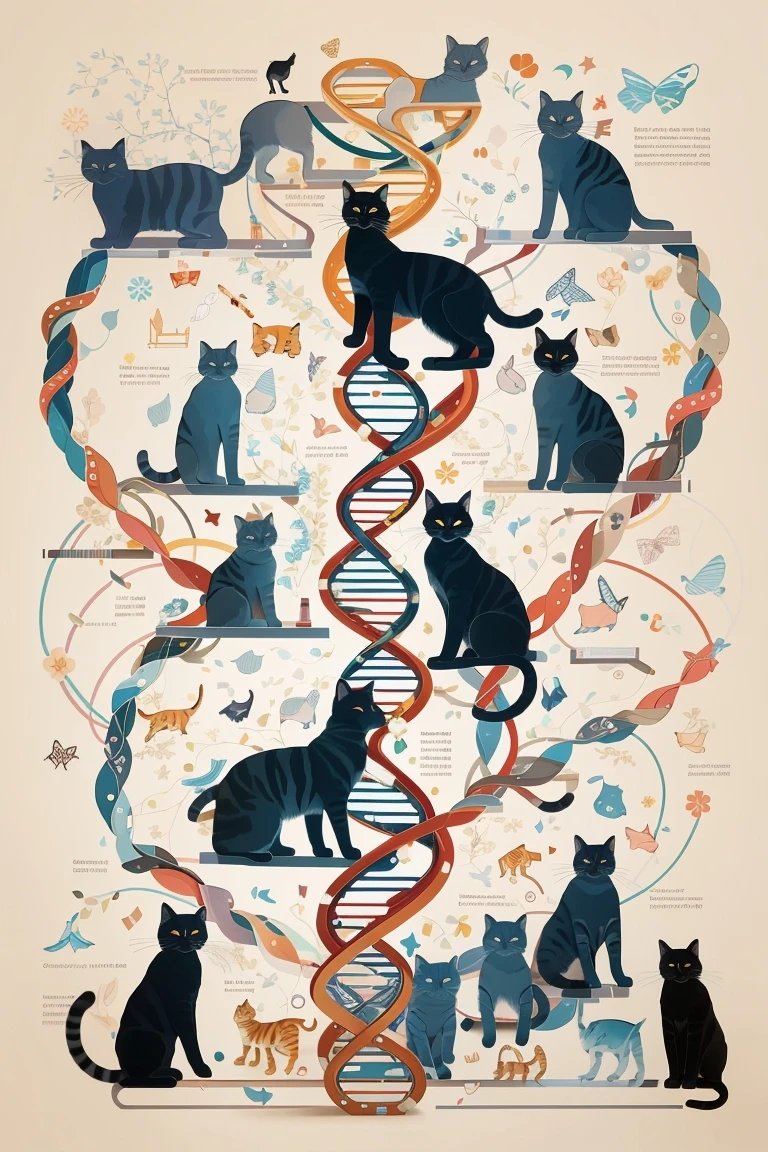Understanding Cat Genetics

Understanding Cat Genetics
Cat genetics determine the physical characteristics and traits that make each cat unique. By understanding the basic principles of how genes are inherited, you can better appreciate the diversity of colors, patterns, body types, and behaviors seen across different cat breeds. This guide will provide an overview of key genetics concepts and how they apply to cats.
Genetics Basics
Genetics is the study of genes, which are segments of DNA that contain the instructions for specific traits. Cats have 19 pairs of chromosomes that contain their genetic material. Each chromosome pair contains one chromosome inherited from the mother and one from the father.
Some key genetics terms:
- Gene - A segment of DNA that codes for a specific trait
- Allele - The variants of a gene
- Dominant allele - An allele that is expressed when present (masking the recessive allele)
- Recessive allele - An allele that is only expressed if the dominant allele is not present
- Homozygous - Having two identical alleles for a gene
- Heterozygous - Having two different alleles for a gene
Coat Color Genetics
Coat color is one of the most visible examples of cat genetics at work. Here are some of the main coat color genes and alleles in cats:
Orange (O)
- Alleles: Black (B), Orange (O)
- Dominance: O is dominant over B
- Effects: Cats with two O alleles will have orange fur. Cats with one O and one B allele will have black fur.
Agouti (A)
- Alleles: Agouti (A), Non-agouti (a)
- Dominance: A is dominant over a
- Effects: The agouti gene produces tabby striping. Cats with two recessive a alleles will be solid colored without tabby patterns.
Dilute (D)
- Alleles: Full color (D), Dilute (d)
- Dominance: D is dominant over d
- Effects: The dilute allele lightens black fur to blue and orange fur to cream.
White Spotting (S)
- Alleles: Full color (S), White spotting (s)
- Dominance: S is dominant over s
- Effects: The white spotting gene produces white patches. Two recessive alleles (ss) produce extreme white spotting.
Cat Coat Patterns
In addition to color, genes control the patterns seen in cat coats:
- Tabby - Classic, mackerel, spotted, ticked tabby patterns are produced by the agouti gene interacting with other genes like ticked and mackerel.
- Tortoiseshell - Cats with an O and B allele on the X chromosome exhibit a mottled mix of black and orange.
- Calico - A modification of tortoiseshell with large white spotting, found almost exclusively in females.
- Tuxedo - A form of bicolor spotting with black bodies and white paws, chest, and face.
- Van - White cat with color restricted to the tail and head. Controlled by the white spotting gene.
- Point - Siamese pattern with color concentrated on the extremities. Controlled by the temperature sensitive albino gene.
Cat Coat Textures
The length and texture of the fur is also determined genetically:
- Short hair - Dominant allele produces short smooth coat.
- Long hair - Recessive long hair allele produces a semi-longhair or longhair coat.
- Wirehair - Recessive wirehair allele produces coarse, wiry fur.
- Hairless - Recessive hairless allele inhibits fur growth.
Other Genetic Traits
In addition to coat appearance, other genetic traits help define a cat's characteristics:
- Body type - Body and bone structure is influenced by genes. Some breeds are long and slender while others are stocky.
- Dwarfism - Recessive allele causes short limbs and tail.
- Polydactyl - Dominant allele causes extra toes.
- Tail length - Various alleles control tail length. The dominant Manx allele causes a shortened tail.
- Fur color - Blue eyes and odd-eyed cats occur when the orange gene is also present. White cats are often deaf if they have blue eyes.
- Behavior - Personality and temperament have genetic factors, although environment also plays a key role.
Breeds and Hybrid Cats
There are over 70 recognized cat breeds that have distinct looks resulting from selective breeding. Some examples:
- Siamese - Pointed pattern, long body, blue eyes
- Maine Coon - Long semi-longhair tabby coat, large build
- Sphynx - Hairless
- Manx - Tailless or stubby tails
- Persian - Longhair, round head, flat face
Hybrid cats like the Bengal combine the genetics of domestic cats with wild cat breeds. Unique fur patterns, colors, and behaviors result.
Genetic Health Issues
Certain genetic conditions are seen more often in some cat breeds:
- Hypertrophic cardiomyopathy - Heart disease in Maine Coons and other breeds.
- Progressive retinal atrophy - Degenerative eye disease leading to blindness.
- Polycystic kidney disease - Cysts develop on the kidneys.
- Osteochondrodysplasia - Dwarfism in Scottish Folds.
Reputable breeders screen breeding cats for genetic diseases to reduce their prevalence.
The Genetics of Cat Behavior
While genetics influence behavior, a cat's personality is also shaped by early life experiences. Some behavioral traits influenced by genetics include:
- Activity level - Some cats are more playful and energetic than others.
- Lap cats - Affection and desire for human interaction has genetic factors.
- Vocalization - Tendency to meow or chatter.
- Hunting instinct - Pointers freeze and stalk prey more than other breeds.
- Aggression - Influenced by genetics but strongly shaped by socialization. Underlying medical issues can also cause aggression.
- Anxiety - Nervousness and stress have genetic components.
Early socialization and a loving home life help any predispositions towards fearful or aggressive behaviors.
The Takeaway on Cat Genetics
Understanding the interplay between genes to produce unique combinations of traits is endlessly